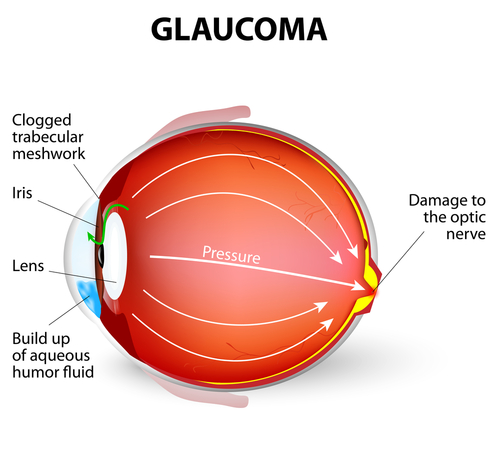Glaucoma is a serious eye condition that affects the vision of an estimated 3 million Americans and is the second leading cause of blindness worldwide. Often, vision impairment due to glaucoma can take years to become noticeable.
Because of this, it leads to a late-stage diagnosis and a higher likelihood of vision loss. You should schedule eye exams regularly with your ophthalmologist to prevent glaucoma from stealing your clear vision.
Glaucoma is most treatable when diagnosed and treated early. Early diagnosis and treatment is the best way to protect your vision from the effects of glaucoma. Keep reading to learn more about glaucoma and how soon you should start treatment.
What is Glaucoma?

Glaucoma is an eye condition that occurs when the fluid in the eye, known as aqueous humor, does not properly drain from the eye. As this fluid collects, it increases the eye’s intraocular pressure (IOP).
When this happens, it leads to severe and permanent damage, causing serious damage to the optic nerve. A healthy optic nerve is vital for good eyesight.
It has the critical task of relaying visual information from the eyes to the brain to create visual perception. While there are several types of glaucoma, the two major types are primary open-angle glaucoma and angle-closure glaucoma (sometimes known as closed-angle glaucoma or narrow-angle glaucoma).
Primary Open-Angle Glaucoma
Primary open-angle glaucoma is the most commonly diagnosed type of glaucoma. This type of glaucoma happens gradually, as the eye fails to drain intraocular fluid as well as it should, causing increased pressure in the eye.
This type of glaucoma is usually painless and affects vision only after a long period as pressure slowly builds up within the eye. There aren’t usually any side effects until later with this form of glaucoma.
Angle-Closure Glaucoma
Angle-closure glaucoma occurs when the iris blocks the drainage area in the eye. If this happens, it traps fluid at the front of the eye, resulting in a very rapid pressure buildup.
Like open-angle glaucoma, angle-closure glaucoma may develop slowly. Angle-closure glaucoma may not affect your vision until you experience a sudden onset of symptoms called an “acute attack.”
What are the Symptoms of Glaucoma?

Because it takes years to develop, glaucoma can have no symptoms in its earliest stages. Often, patients first discover they have glaucoma when it is diagnosed at an eye exam with their ophthalmologist.
As it develops, primary open-angle glaucoma patients report symptoms like hazy vision or blind spots in their peripheral vision. Patients with glaucoma often don’t realize they have it until irreversible vision loss has already occurred. These symptoms may be mild or very difficult to notice at first but usually intensify by the later stages of glaucoma.
For glaucoma patients with angle-closure glaucoma, symptoms appear seemingly out of nowhere in an acute attack. These symptoms include sudden and severe eye pain, blurred vision, headache, nausea, and eye redness.
An acute attack of angle-closure glaucoma is a serious medical emergency. If you think you’re experiencing angle-closure glaucoma, you must see a doctor immediately, as it is a medical emergency.
What are the Treatments for Glaucoma?
Because there is currently no known cure for glaucoma, treatments focus on slowing the condition’s progression and preventing further optic nerve damage. What treatment your eye doctor may recommend often depends on your diagnosis and the severity of symptoms you’re experiencing.

Glaucoma treatments aim to reduce the amount of pressure within the eye. Your eye doctor may initially prescribe special eye drops or oral medications that work to relieve pressure in your eye.
For more advanced cases of glaucoma, your eye doctor may suggest a surgical procedure. At Batra Vision Medical Group, we offer the following surgical procedures to glaucoma patients:
Trabeculectomy
Trabeculectomy is a procedure that creates a new pathway for fluid within the eye to drain more effectively. Creating a new path helps reduce intraocular pressure by removing part of the trabecular meshwork and necessary structures in the eye.
Valve Implantation
Often performed in combination with a trabeculectomy, valve implantation is a procedure that implants a tube into the front of the eye to assist in fluid drainage and pressure reduction. Reducing pressure in the eye helps improve glaucoma symptoms.
Laser Surgery
Laser surgery uses a laser to open the fluid channels of the eye, increasing drainage. Laser surgery can be used as a one-time treatment or as an ongoing treatment to manage glaucoma over time.
iStent
The iStent is an innovative treatment for glaucoma that involves implanting a very tiny medical device within the eye that creates a permanent opening for the drainage of eye fluid. Implanting the iStent helps improve the aqueous outflow while continuously lowering intraocular pressure. Dr. Batra was among the first to offer the iStent for glaucoma patients in the Bay Area.
Who is Most at Risk for Developing Glaucoma?

Although anyone can develop glaucoma, most patients with the condition can be grouped into one or more of the following categories:
- Age 60 or older: Glaucoma is seen most often in individuals over the age of 60 due to the effects of aging on the eye.
- Family history: While it has not been proven that glaucoma is a genetic eye condition, it’s more common if you have a close relative, like a parent or sibling, with the condition.
- Medical history: Certain chronic health conditions, including diabetes, hypertension, and cardiovascular disease, can increase the likelihood of developing glaucoma.
- Ethnicity: For unclear reasons, certain ethnic groups are more likely to develop glaucoma. At higher risk are individuals who are African American, Hispanic, or Asian.
- Thin corneas and other eye conditions: Thin corneas, retinal detachment, chronic eye inflammation, and optic nerve abnormalities increase your risk of developing glaucoma.
If left untreated, glaucoma can cause serious, permanent visual impairment, from blind spots to the complete loss of eyesight. If you have received a glaucoma diagnosis, you can help prevent glaucoma from being “the silent thief of sight” by starting the recommended treatment as soon as possible!
Learn more about glaucoma and the best ways to treat it by requesting an appointment at Batra Vision in San Leandro, CA, now!

 Follow Us!
Follow Us!